Gaze out over timeless glaciers, deep valleys, and cascading waterfalls on the ‘Going-to-the-sun Road’ in Glacier National Park. Smell rich sulfur as steam rises to the clouds over Yellowstone National Park. Grab a jacket and descend into the otherworldly caverns of Lewis & Clark Caverns.
Montana’s national parks include the well-known Yellowstone National Park, Glacier national park, Lewis & Clark Trail, Ice Age Flood, and much more. Here is a list of the nine best national parks in Montana. I’ve also included six wonderful state parks that dazzle every visitor.
In this article:
- Montana National Parks Map (+ state parks)
- 9 Best Montana National Parks
- Yellowstone National Park
- Glacier National Park
- Nez Perce National Historical Park
- Grant-Kohrs Ranch National Historic Site
- Bighorn Canyon National Recreation Area
- Fort Union Trading Post National Historic Site
- Ice Age Floods National Geologic Trail (Multiple sites)
- Lewis & Clark National Historic Trail (Multiple sites)
- Upper Missouri River Breaks National Monument
- Montana State Parks Map
- 6 Best Montana State Parks
Montana national parks map (+ state parks)
Map of national parks in Montana:
How many national parks are in Montana?
There are 9 national parks in Montana:
- Yellowstone National Park
- Glacier National Park
- Nez Perce Historical National Park
- Grant-Kohrs Ranch National Historic Site
- Upper Missouri River Breaks National Monument
- Bighorn Canyon National Recreation Area
- Fort Union Trading Post National Historic Site
- Ice Age Floods National Geologic Trail
- Lewis & Clark National Historic Trail
What is the famous park in Montana?
The most well-known park in Montana is Yellowstone National Park. Yellowstone national park contains the Old Faithful Geyser, many colorful hot springs, and abundant wildlife in a preserved ecosystem.
But Montana has nine total national parks, each one unique and enchanting in its own way. Here is our list of all the national parks in Montana.
9 best Montana national parks
1. Yellowstone National Park
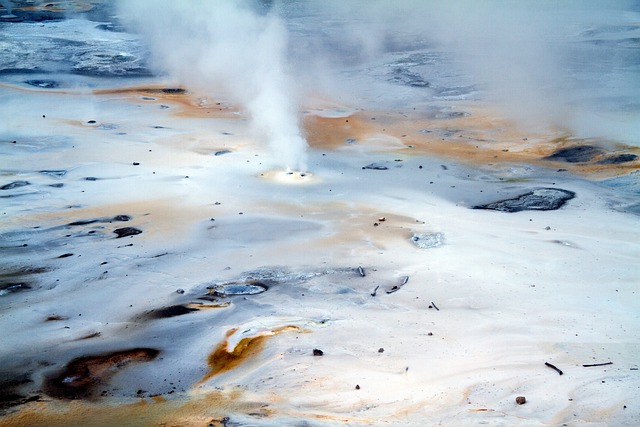
Yellowstone National Park was established on March 1, 1872, and was the world’s first national park. It’s one of the most well-known national parks in the United States because of its exotic, otherworldly beauty, and it lives up to its reputation. When someone asks, “what national park is in Montana?”, they might be referring to Yellowstone.
What to see and do in Yellowstone National Park
This is a fully intact, preserved, maintained ecosystem with a range of flourishing wildlife. The 2.2 million acres of this Montana national park contain about half of the world’s active geysers, plus other geological wonders like the Grand Canyon of the Yellowstone River.
White, orange, and blue-ringed geysers steam and bubble. Old Faithful regularly shoots a column of geothermal water 100 to 180 ft (30 to 55 m) into the air every 44 minutes to two hours. Roads lead to some of the most spectacular areas of the park and the boardwalks take visitors safely around the geysers.
Visitors can enjoy scenic drives where they’re likely to see bison, moose, bears, and other native wildlife along the way. Otherwise, you can get out of your car and walk the hiking trails – though this is recommended with caution, due to the wildlife threat.
Yellowstone National Park on the map:
*BEAR ALERT: The bear threat in Montana is serious – especially in a fully intact ecosystem like Yellowstone National Park. Always carry bear spray and bear bells with you.
*HOT SPRINGS: Hot springs in Yellowstone aren’t suitable for swimming and can even be fatal. If you’re interested taking a dip in the refreshing geothermal waters of Montana, try one of the many other hot springs in Montana.
2. Glacier National Park
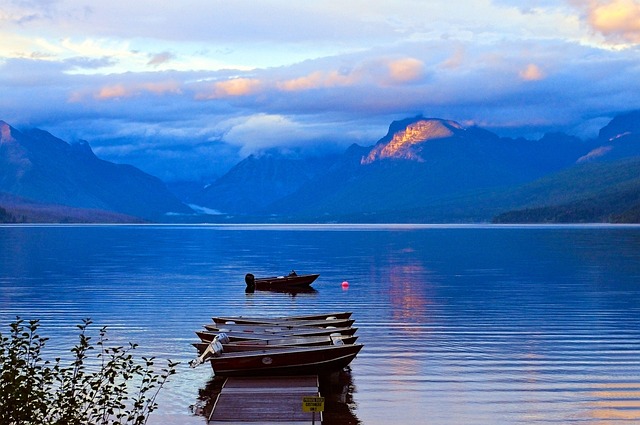
The mountains of Glacier National Park were carved by prehistoric rivers and glaciers. Today, dramatic valleys, rolling glaciers, towering peaks, and human history are on display in this Montana National Park.
Here, visitors can see about 25 different sparkling glaciers and 200 glistening lakes. The park features relatively few roads, leaving the majority of this ecosystem intact and undisturbed. One of the most popular journeys through this Montana national park is the ‘Going-to-the-sun’ road, which traverses the entire park, crossing the Continental Divide at Logan pass at 6,646 ft elevation (2,026 m).
Visitors can camp, hike, cross-country ski, boat, swim, and do a range of other activities in this Montana national park. Guided tours are available and there are multiple lodging and camping options inside the park as well.
Glacier National Park on the map:
3. Nez Perce National Historical Park
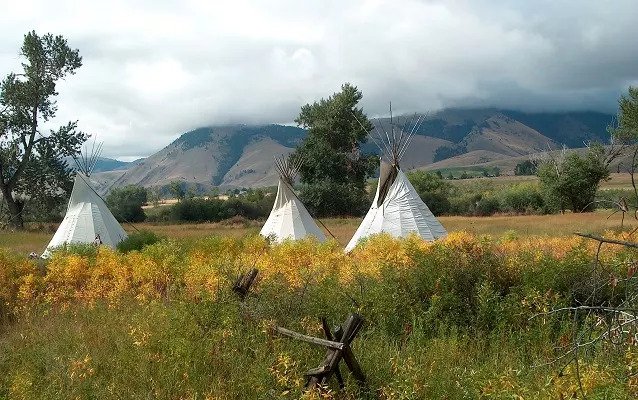
The inland region of the Northwest around Washington, Oregon, and Idaho has been home to the resilient nimíipuu people (or Nez Perce) for roughly 11,500 years. The Nez Perce Historical National Park features multiple sites of historical and cultural importance to the Nez Perce people, four of which are in Montana:
- Canyon Creek Battlefield and Highway Pullout
- Big Hole National Battlefield
- Lolo Trail (Site on Lewis & Clark National Historic Trail)
- Bear Paw Battlefield
These four points primarily mark tragic moments where battles ensued between the Nez Perce and the U.S. Cavalry. However, one site in this Montana national park is the trail used by the nimíipuu long before the Euro-Americans arrived – the Nez Perce (Ni-Mi-Poo) National Historic Trail. This trail crosses the Bitterroot Mountains from Weippe Prairie to Lolo Pass and is also known today as the Lolo Trail.
Lolo Trail is in a beautiful region of Montana and we highly recommend grabbing your bear spray and bear bells and taking a hike here.
Nez Perce National Historical Park on the map:
4. Grant-Kohrs Ranch National Historic Site
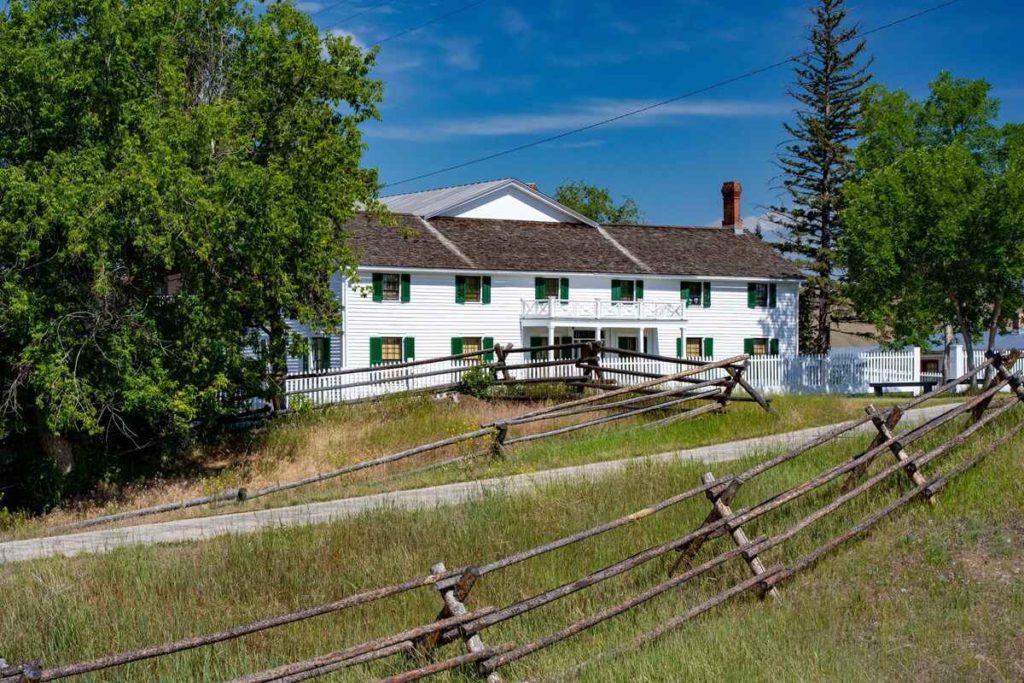
The western cattle industry began in the 1850s and gave birth to cattlemen, their horses, and open prairies with herds of grazing cattle. The Grant-Kohrs Ranch National Historic Site is a Montana national park that memorializes these icons of the western United States.
A Canadian fur trader, Johnny Grant, established the original ranch on this site in 1862 at a place called Cotton Creek, Montana (later to become Deer Lodge, Montana). Conrad Kohrs later expanded the ranch. Once the headquarters of a 10 million acre cattle empire, today the ranch occupies 1,618 acres (655 hectares) of land.
This Montana national park was originally designated a National Historic Landmark in 1960 and today the National Park Service maintains it as a working ranch. Visitors can explore the 88 historic structures, take a guided tour, and partake in a ranger program to learn the history of the open cattle era and its impact on the nation’s development.
Grant-Kohrs Ranch National Historic Site on the map:
5. Bighorn Canyon National Recreation Area
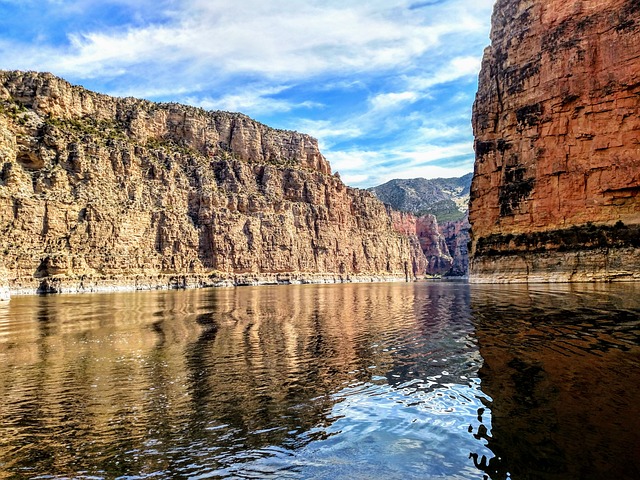
This isn’t exactly a Montana national park. Rather, it’s called a national recreation area. But if you’re looking to explore the natural beauty of Montana, Bighorn Canyon won’t disappoint.
Bighorn Canyon consists of 120,000 acres of diverse wildlife and has been inhabited by humans to some degree for 10,000+ years. Many visitors come with a boat to float the waters and explore the fingers and inlets that twist and crawl between the vertical walls of earth. The reservoir sits in a valley between towering, often vertical, rock walls, making for an unforgettable boat ride.
However, there are also over 17 miles of hiking trails, offering short walks and hikes to scenic viewpoints and campsites. Take in the fresh, crisp, natural air by camping under the stars in this incredible national park in Montana.
Bighorn Canyon National Recreation Area on the map:
6. Fort Union Trading Post National Historic Site
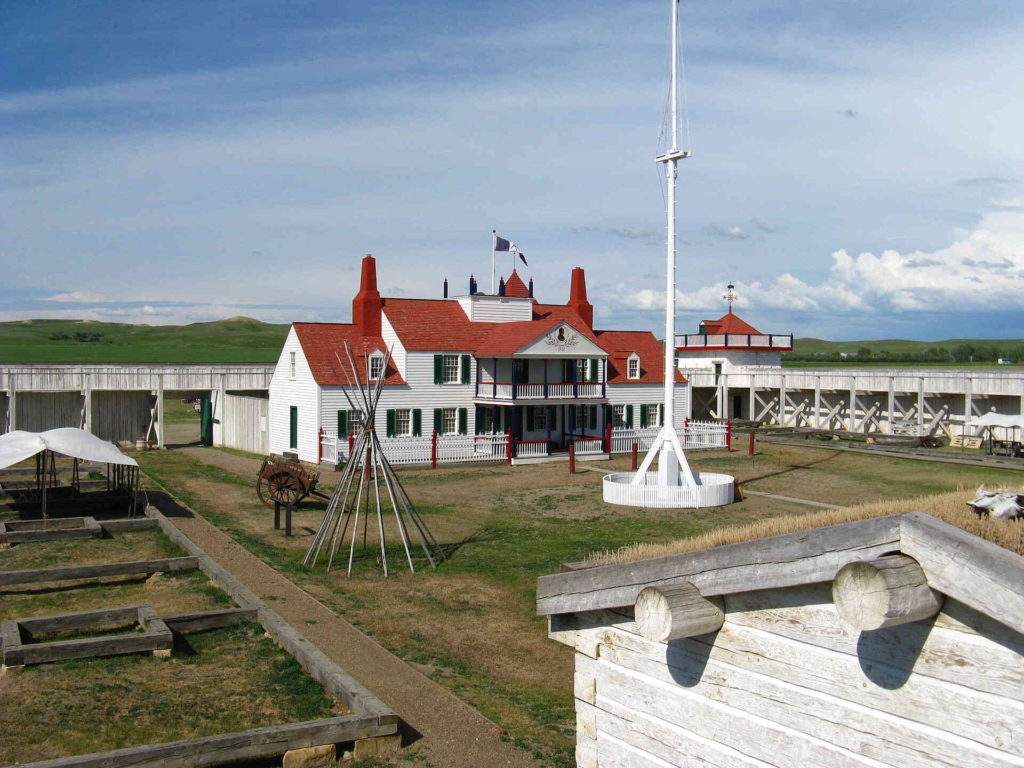
The Fort Union Trading Post also isn’t a typical Montana national park. Rather, it’s a national historic site. However, anyone interested in both the history and natural beauty of Montana will enjoy themselves here.
The Fort Union Trading Post was at one time the most important trading posts of the region and a bastion of peaceful coexistence for decades. From 1828 to 1867, seven local Northern Plains tribes traded robes and furs at the Fort Union Trading Post for a range of goods from different countries.
The post is located just 0.3 miles (0.5 km) past the Montana-North Dakota border, near Buford. Today, visitors can see the Trade House, hike the Missouri trail, and come for special events, such as the Fort Union Rendezvous, Indian Arts Showcase, Living History Weekend, and Kids Craft Days.
The entire well-preserved site is a historical artifact that transports you back in time.
Fort Union Trading Post National Historic Site on the map:
7. Ice Age Floods National Geologic Trail
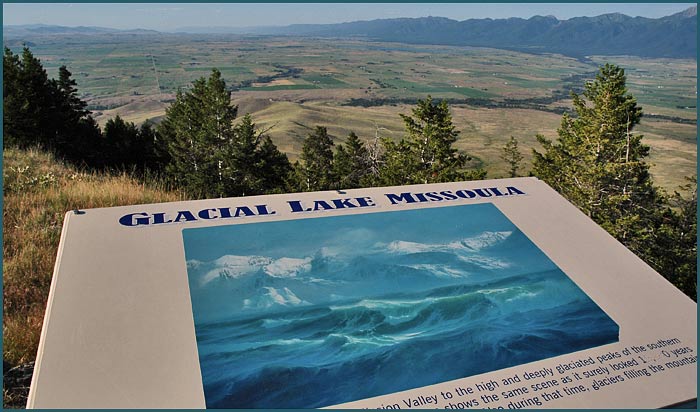
About 18,000 to 15,000 years ago (Upper Paleolithic Period), near the end of the last ice age, an ice dam located in present-day northern Idaho had created Glacial Lake Missoula.
The lake covered about 3,000 square miles (7,770 sq km) around present-day Missoula. When the dam burst, flood waters rushed across Montana, Idaho, Washington, and Oregon before reaching the Pacific Ocean. These floods were some of the largest to occur on earth and reshaped the landscape and lifestyle of the Montana-Idaho-Oregon-Washington-region.
View the remnants of Glacial Lake Missoula in Montana
You can see remnants of Glacial Lake Missoula at sites along the Ice Age Floods National Geologic Trail:
- Missoula. You can see the glacial lake shorelines on the hills surrounding the town, especially on the hills marked with an “M” and “L”. Missoula is one of the most pleasant places to live in Montana and makes for a pleasant place to stay if you visit this region.
- Camas Prairie. Flood ripples 15 to 50 ft high (4.5 to 15.2 m) and 300 ft to a half-mile long (91 to 805 m) can be seen from Highway 382 at Camas Creek Rd, north of Camas Prairie.
- National Bison Range. The National Bison Range is an 18,766-acre area for the preservation and management of a local bison population where signs of former Glacial Lake Missoula and its water movements are visible.
- Eddy Narrows. This tight canyon on the Clark Fork River between Plains and Thompson Falls throttled the floodwaters. The raging waters scoured the valley walls down to the bedrock up to 1,000 ft (305 m) above the valley floor.
There are plenty of other historic sites along the Ice Age Trail in Idaho, Washington, and Oregon. Be sure to check them out if you’re traveling through these states as well.
Ice Age Floods National Geologic Trail on the map:
8. Lewis & Clark National Historic Trail
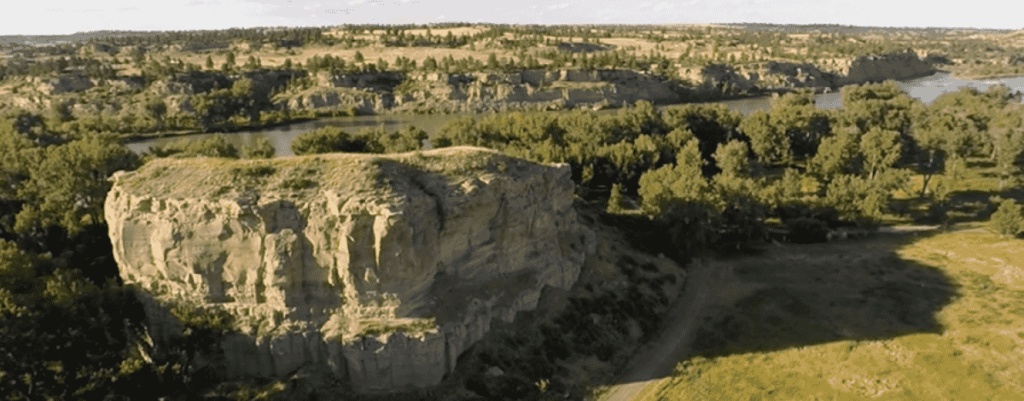
From Pittsburgh, Pennsylvania to the Pacific Ocean, Lewis and Clark on their Corps of Discovery Expedition crossed 4,900 miles (7,886 km) through 60 Tribal nations. Their outbound and inbound trail crosses 16 modern-day states. Today, the Lewis & Clark National Historic Trail follows their path and features monuments commemorating key events on their journey.
This Montana national park reveals what it was like for the Corps as they passed through Montana. Sites include:
- Pompey’s Pillar National Monument. Here, Clark carved his name and date on the top of a large, beautiful, rock formation. Today, it’s the only remaining physical evidence of the expedition. It’s located 30 mi (48 km) northeast of Billings, Montana.
- Montana Historical Society & Montana’s Museum. A museum that sits nearby the Lewis and Clark trail in Helena, Montana. The museum preserves books, artwork, and other artifacts of Montana’s heritage.
- Travelers’ Rest State Park. The Corps rested here from September 9 – 11, 1805, before crossing Lolo Pass and continuing on to the Pacific.
- Lolo Trail (Lolo Pass). The historic trail the Corps followed over Lolo Pass in the Bitterroot Mountains in September, 1805.
- Camp Disappointment. Several men from the Corps, including Lewis, camped here from July 22 – 26, 1806. They were in pursuit of the headwaters of the Missouri River, in hopes that it lay beyond the 49th parallel, which would extend the northern boundary of the Louisiana Purchase. Today, a monument off Highway 2, 12 miles east of Browning, Montana, marks the spot of their camp.
- Square Butte. Lewis described this mountain in his journals, naming it “Fort Mountain,” on July 14, 1805.
- Clark’s Canoe Camp on the Yellowstone. Clark’s party camped here from July 19 – 24, 1806. After traveling 100 miles (161 km) down the Yellowstone River, they discovered Cottonwood trees here suitable for creating canoes and set up camp. It’s located near present-day Park City, Montana, though as of writing there is no marker on the location.
- White Cliffs. A spectacular set of cliffs in the Missouri Breaks region the Corps passed through on May 31, 1805. Lewis described them as having “a most romantic appearance”.
- Clark’s Lookout State Park. A limestone outcropping that Clark climbed on August 13, 1805, from which he made compass readings, sketched a map, and assessed the route ahead for his exhausted crew. One mile north of beautiful Dillon, Montana.
- Great Falls Portage. When Lewis and Clark reached the Great Falls of the Missouri River on June 13, 1805, they faced one of the largest challenges of the trip – carrying all equipment and supplies 18 miles overland in intense heat. The Upper Portage is on the south side of Great Falls and the Lower Portage is northeast of Great Falls.
Lewis & Clark National Historic Trail on the map:
9. Upper Missouri River Breaks National Monument
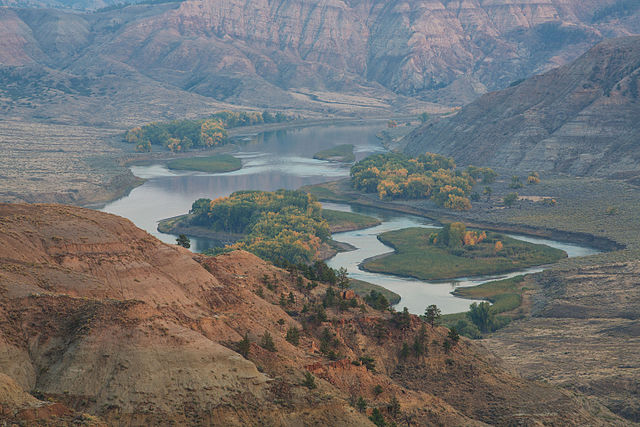
This national park in Montana consists of 149 miles of the scenic Missouri river flowing through rock outcroppings and golden hillsides that have remained untouched for centuries.
History of the Upper Missouri Breaks
The Upper Missouri River Breaks (or simply the “Missouri Breaks”) covers 377,000 acres (152,566 hectares) and was the homeland and lifeblood for many Native American tribes, such as the Gros Ventre, Blackfoot, Crow, and Assiniboine. This section of the Missouri River also served as a transit route for Lewis and Clark and later became a waterway for steamboats and traders.
Things to see and do at the Upper Missouri Breaks
Visitors marvel at the unique geological formations along the Missouri river and enjoy a multitude of historical sites, such as Native American encampments, Lewis and Clark campsites, steamboat landings, and abandoned homesteads. Visitors may float the river, hike, take a scenic drive, or simply wonder at the range of resources all around.
Accessing the Upper Missouri Breaks by car
Large areas of this national park in Montana are accessible only via gravel roads, some of which are suitable only for high-clearance vehicles. Many of the park’s roads cross through areas that are impassable when wet and other areas aren’t accessible by any roads, enticing visitors to explore on foot. As always, explore with caution and avoid taking risks when driving conditions aren’t ideal.
Upper Missouri River Breaks National Monument on the map:
While Montana’s national parks lure visitors from around the world each year, Montana’s state parks are no less enchanting. Here are six breathtaking state parks that are well worth a visit.
6 best Montana state parks
- Lewis & Clark Caverns State Park
- Pictograph Cave State Park
- Lone Pine State Park
- Makoshika State Park
- Bannack State Park
- Giant Springs State Park
Let’s look at each one in detail.
1. Lewis & Clark Caverns State Park
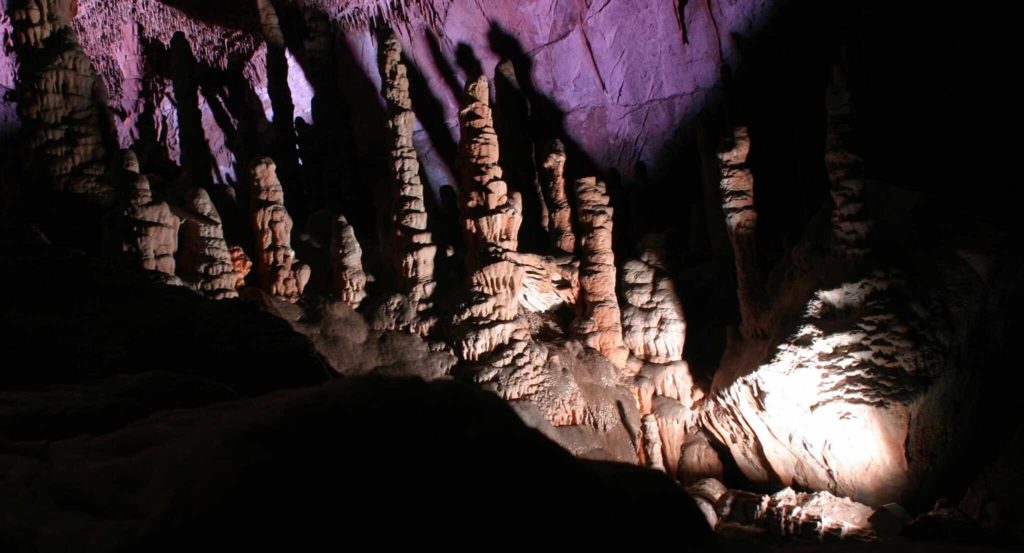
While this site isn’t recognized as a Montana national park, don’t let that dissuade you from visiting. Here, visitors can descend beneath the earth’s surface in one of the most decorated limestone caverns in the northwest United States. The walls, ceilings, and floor of the caverns are lined with brilliantly lit stalactites, stalagmites, and columns.
The 2-mile journey through the caverns lasts for about 2 hours. Above ground, there is a walking trail for visitors to explore the surrounding area. The entire grounds cover 3,000 acres (1,214 hectares) at 4,300 ft (1,311 m) and 5,600 ft (1,707 m) elevation.
Visitors can stay the night in the on-site campground, RV camp, or rent a cabin.
Lewis & Clark Caverns State Park on the map:
2. Pictograph Cave State Park

About 2,000 years ago, prehistoric hunters camped in the Pictograph Cave and painted images in white and black pigments. 1,500 years later, inhabitants left behind images of rifles and horses and hundreds of artifacts.
The Pictograph Cave became a Montana national park in 1964. A three-mile trail takes visitors on a loop to Pictograph, Middle, and Ghost caves before returning to the visitor center and picnic tables. To see the images on the walls of Pictograph Cave, we recommend bringing a pair of binoculars.
While this area also doesn’t have the Montana national park designation, it offers immersion into the rich history of this area and its stunning natural beauty.
Pictograph Cave State Park on the map:
3. Lone Pine State Park
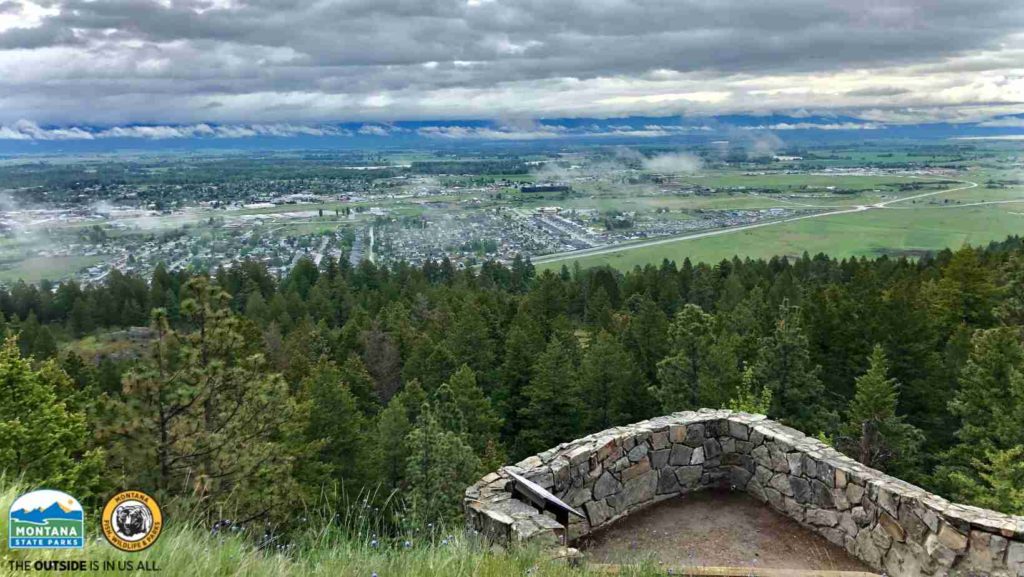
Lone Pine State Park puts Montana’s rich beauty on display. This Montana State Park is located in the Flathead Valley near Kalispell, Montana. It covers 270 acres (109 hectares) and sits at an elevation of 2,959 ft (902 m) to 3,709 ft (1,131 m).
Visitors here enjoy expansive views over the Flathead Valley reachable by several miles of wonderful trails. Many visitors come here to hike, mountain bike, and snowshoe. There is also a fully-equipped Visitor Center with a TV, surround sound, projector, and all necessities for meetings, weddings, and other family and business events.
Lone Pine State Park on the map:
4. Makoshika State Park
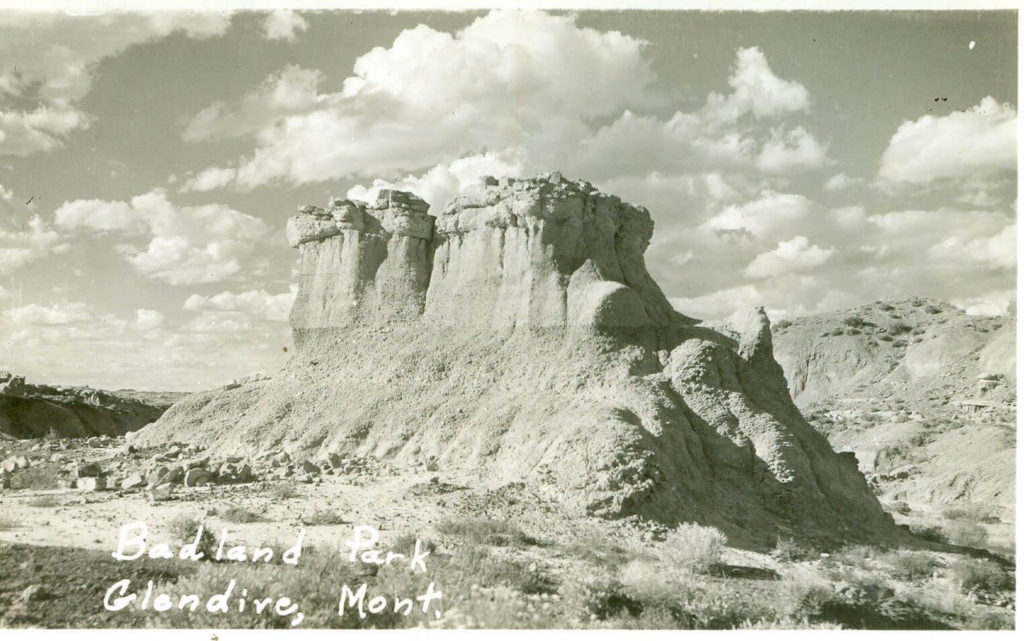
Makoshika State Park in Montana welcomes visitors to the prehistoric world of the Thescelosaurus and Triceratops. Back in 1997, Jack Horner and Bob Harnon discovered dinosaur fossils in the area.
The Lakota tribe called this area Makoshika, which means ‘bad land’. Pine and Juniper trees are speckled across a dry, arid land amidst otherworldly rock formations and barren hills, some cone-shaped.
In 1938 the Glendive Chamber wrote to federal officials proposing this area as a Montana national park. While it didn’t receive national status, it became a state park a year later. It is the largest state park in Montana, covering 11,000 acres (4,452 hectares).
Things to see and do at Makoshika State Park
Today, Makoshika features camping and picnicking, plus geology and fossil displays at the visitor center. Throughout the park are hiking trails and scenic drives.
Makoshika State Park on the map:
5. Bannack State Park
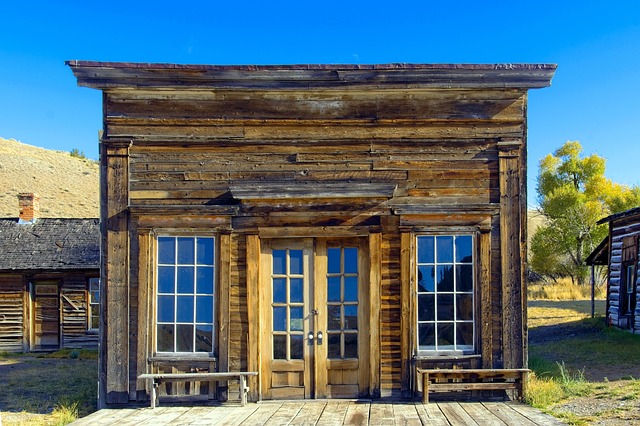
The town of Bannack emerged in 1862, on the back of a gold discovery in the region. This was the first place anyone searched for gold in the state. It eventually reached 3,000 inhabitants and was such an important center that it became the state capital. After the last gold was extracted from the nearby mines, the town slowly started to decline until it was fully abandoned in 1971.
Today, Bannack State Park is a well-preserved ghost town and one of the most unique places to visit in Montana. If you’ve ever visited the western states, then you’ve likely come across the many ghost towns each state has to offer. Bannack is just one of the many alluring ghost towns of Montana, though it’s one of the most well-preserved.
Bannack features multiple buildings that still stand today. Visitors can stroll the main street, which is lined with houses, hotels, stores, and stables and there are guided tours of the old factory. While Bannack isn’t a designated Montana National Park, it is a historic heritage of the state and all of the US.
Bannack State Park on the map:
6. Giant Springs State Park
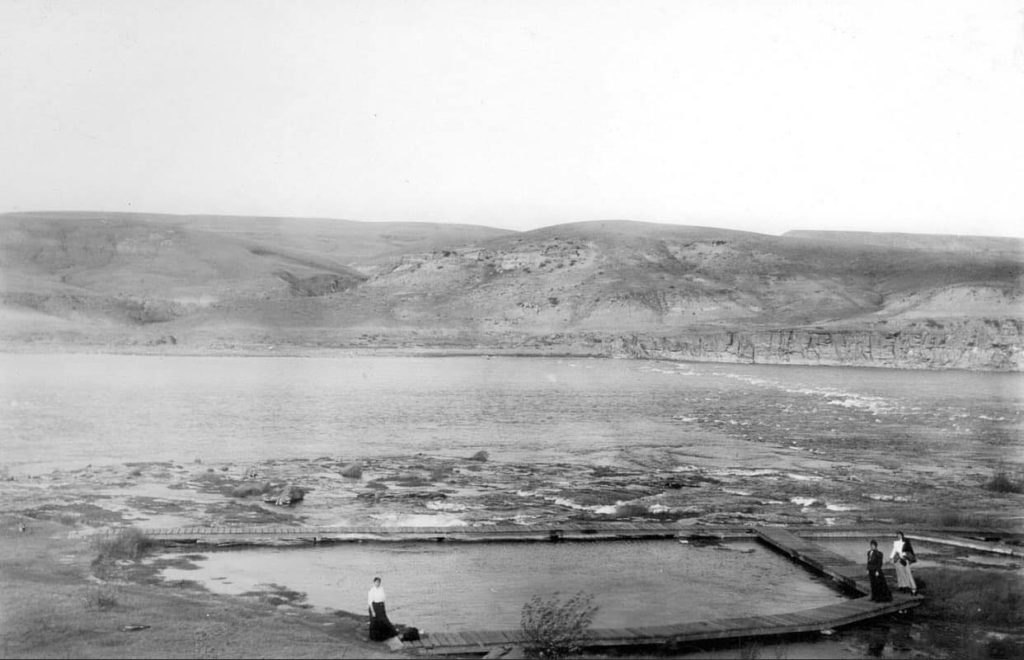
William Clark of the Lewis & Clark Expedition described Giant Springs State Park as the largest spring he ever saw, assuming it must have been the largest in the United States. He noted its clarity and bluish tint that remained for a half mile after pouring into the Missouri River. The next day, Lewis and Drouillard visited the spring after hearing Clark’s praise. Lewis concurred.
Giant Springs is a freshwater spring and the headwaters of the Roe River, which flows only a couple hundred feet before joining the Missouri River. It’s one of the largest freshwater springs in the United States.
The nearby town of Great Falls was established in 1883. Shortly after, Giant Springs became a popular place of recreation for Great Falls residents. The Giant Springs State Park was established in 1970. Today, visitors come for the incredible views and network of hiking trails up and down the Missouri River.
Giant Springs State Park on the map:
Montana state parks map
Find the above six Montana state parks on this map:
Montana National Parks and State Parks FAQ
Before closing this article, I’ve grouped the best state and national parks in Montana into regions. Find out below which state and national parks in Montana are nearest to which city.
Montana state parks near Glacier
- Lone Pine State Park. 7.5 miles (12 km) of recreation on the southwest side of Kalispell – hiking, mountain biking, snowshoeing, and horseback riding.
- Flathead Lake State Park. Large body of freshwater with crystal clear water – an ideal place for summer activities like swimming.
- Logan State Park. Recreation area on Middle Thompson Lake encompassing 17 acres (7 hectares) within the 3,000-acre (1,214-hectare) Thompson Chain of Lakes State Park – swimming, boating, and camping.
Montana national parks, sites, and areas near Glacier:
- Square Butte (Site on Lewis & Clark National Historic Trail). Lewis noticed this butte and named it “Fort Mountain” on July 14, 1805, noting “those mounds before mentioned near the falls have much the same appearance but are none of them as large as this one.”
- Camp Disappointment (Site on Lewis & Clark National Historic Trail). The northernmost campsite of the Corps, on a journey north to determine if the Missouri river ran beyond the 49th parallel, which would extend the northern boundary of the Louisana Purchase.
- National Bison Range (Site of Ice Age Floods National Geologic Trail). An 18,766-acre (7,594-hectare) preservation area for a local bison population featuring signs of former Glacial Lake Missoula and its water movements.
- Camas Prairie (Site of Ice Age Floods National Geologic Trail). The Ice Age Flood left 15 ft high (4.5 m), 300 ft long (91 m) ripples in the land here, visible in this prairie.
- Eddy Narrows (Site of Ice Age Floods National Geologic Trail). A narrow canyon on the Clark Fork River that throttled the Ice Age Flood, stripping the canyon walls to the bedrock up to 1,000 ft (305 m) from the valley floor.
On the map:
Montana state parks near Yellowstone
- Bannack State Park. A well-preserved ghost town.
- Beaverhead Rock State Park. A natural, historic rock formation overlooking the Beaverhead River in Montana.
- Madison Buffalo Jump State Park. A limestone cliff carved by the Madison river on the edge of a wide valley. Native Americans used it for 2,000 years.
- Missouri Headwaters State Park. A public recreation area of 535 acres (217 hectares) around the area of the Missouri River source. Visitors here enjoy camping, hiking, and water activities.
- Lewis & Clark Caverns State Park. Beautifully decorated caverns with stalactites, columns, and helicities under colorful lighting.
- Clark’s Lookout State Park (Site on Lewis & Clark National Historic Trail). An 8-acre (3-hectare) park that covers the hill overlooking the Beaverhead River north of Dillon, Montana. On August 13, 1805, Clark climbed up this hill to survey the route ahead.
- Pictograph Cave State Park. A series of caves that were the home of prehistoric hunters. Pictograph cave features paintings from 2,000 years ago.
Montana national parks, sites, and areas near Yellowstone:
- Clark’s Canoe Camp on the Yellowstone (Site on Lewis & Clark National Historic Trail). On July 19, 1806, after traveling 100 miles (161 km) down the Yellowstone River, Clark noticed cottonwood trees in this area large enough to carve canoes from. Clark’s party set up camp here, preparing canoes and stitching clothing until July 24.
- Pompey’s Pillar (Site on Lewis & Clark National Historic Trail). An enormous sandstone outcrop rises 120 ft (37 m) to the sky on this 51-acre (21-hectare) state park. Hundreds of markings, including an inscription from William Clark, make this formation a living journal of Montana’s history.
- Bighorn Canyon National Recreation Area. A 120,000-acre (48,562-hectare) area with a stunning winding reservoir flanked by vertical canyon walls. This historic site is popular for boating, hiking, and camping.
On the map:
Montana state parks near Billings
- Pictograph Cave State Park. A series of caves that were the home of prehistoric hunters. Pictograph cave features paintings from 2,000 years ago.
- Greycliff Prairie Dog Town State Park. A 98-acre (40-hectare) park protects the local black-tailed prairie dog community and offers a wonderful opportunity to see them in person. Bring your camera!
- Cooney Reservoir State Park. A reservoir that’s popular among boaters and campers of south-central Montana. The park occupies a total of 1,078 acres (436 hectares), including the reservoir and surrounding land.
- Lake Elmo State Park. A great place for an outdoor, afternoon swim in the Billings Heights. However, the water has a reputation for being of poor quality.
- Tongue River Reservoir State Park. A 12-mile-long reservoir spread between luscious red shale, juniper canyons, and open prairies.
Montana national parks, sites, and areas near Billings:
- Bighorn Canyon National Recreation Area. A 120,000-acre (48,562-hectare) area with a stunning winding reservoir flanked by vertical canyon walls. This historic site is popular for boating, hiking, and camping.
- Clark’s Canoe Camp on the Yellowstone (Site on Lewis & Clark National Historic Trail). On July 19, 1806, after traveling 100 miles (161 km) down the Yellowstone River, Clark noticed cottonwood trees in this area large enough to carve canoes from. Clark’s party set up camp here, preparing canoes and stitching clothing until July 24.
- Pompey’s Pillar (Site on Lewis & Clark National Historic Trail). An enormous sandstone outcrop rises 120 ft (37 m) to the sky on this 51-acre (21-hectare) state park. Hundreds of markings, including an inscription from William Clark, make this formation a living journal of Montana’s history.
On the map:
Montana state parks near Kalispell
- Lone Pine State Park. 7.5 miles (12 km) of recreation on the southwest side of Kalispell – hiking, mountain biking, snowshoeing, and horseback riding.
- Flathead Lake State Park. Large body of freshwater with crystal clear water – an ideal place for summer activities like swimming.
- Logan State Park. Recreation area on Middle Thompson Lake encompassing 17 acres (7 hectares) within the 3,000-acre (1,214-hectare) Thompson Chain of Lakes State Park – swimming, boating, and camping.
- Whitefish Lake State Park. 10-acre (4-hectare) public recreation area on Whitefish Lake near the town of Whitefish in northwestern Montana. Visitors enjoy boating, swimming, RVing, and tent camping.
- Les Mason State Park. An 8-acre (3-hectare) park on the east shore of Whitefish Lake. Visitors enjoy a long sand and gravel beach, swimming, canoeing, walking trails, and picnicking.
Montana national parks, sites, and areas near Kalispell:
- Glacier National Park. A vast, preserved ecosystem in northwestern Montana featuring deep valleys, glistening glaciers, towering peaks, waterfalls, and clear mountain lakes. Home to the Going-to-the-Sun Road.
- Square Butte (Site on Lewis & Clark National Historic Trail). Lewis noticed this butte and named it “Fort Mountain” on July 14, 1805, noting “those mounds before mentioned near the falls have much the same appearance but are none of them as large as this one.”
- Camp Disappointment (Site on Lewis & Clark National Historic Trail). The northernmost campsite of the Corps, on a journey north to determine if the Missouri river ran beyond the 49th parallel, which would extend the northern boundary of the Louisana Purchase.
- National Bison Range (Site of Ice Age Floods National Geologic Trail). An 18,766-acre area for the preservation and management of a local bison population where signs of former Glacial Lake Missoula and its water movements are visible.
- Camas Prairie (Site of Ice Age Floods National Geologic Trail). Flood ripples 15 to 50 ft high (4.5 to 15.2 m) and 300 ft to a half-mile long (91 to 805 m) can be seen from Highway 382 at Camas Creek Rd, north of Camas Prairie.
- Eddy Narrows (Site of Ice Age Floods National Geologic Trail). This tight canyon on the Clark Fork River between Plains and Thompson Falls throttled the floodwaters. The raging waters scoured the valley walls down to the bedrock up to 1,000 ft (305 m) above the valley floor.
On the map:
Montana state parks near Butte
- Elkhorn State Park. A 19th-century ghost town in the Elkhorn Mountains of southwest Montana. Though, this ghost town is relatively unique – a handful of people have made it their permanent home. A 2020 census put the population at 12.
- Anaconda Smoke Stack State Park. A retired brick smelter stack from the Anaconda Copper Company dating back to 1919 sits atop a hill shooting up 585 ft (178 m) into the sky. A symbol of the struggles the Montana copper industry faced in the latter part of the 20th century.
- Lost Creek State Park. Limestone and granite formations rise 1,200 ft (366 m) off the canyon floor of this park. A popular destination inside the park is a waterfall that careens over a 50 foot (15 m) drop. Visitors often see bighorn sheep and mountain goats on the cliffs above.
- Granite Ghost Town State Park. A silver-mining town that boomed in the 1890s. Today, it’s a quiet, alluring ghost town. The entire scenic walk through town takes about 2 hours.
- Beaverhead Rock State Park. A natural, historic rock formation overlooking the Beaverhead River in Montana.
- Clark’s Lookout State Park (Lewis & Clark National Historic Trail). A limestone outcropping that Clark climbed on August 13, 1805, from which he made compass readings, sketched a map, and assessed the route ahead for his exhausted crew. One mile north of beautiful Dillon, Montana.
- Madison Buffalo Jump State Park. A limestone cliff carved by the Madison river on the edge of a wide valley. Native Americans used it for 2,000 years.
- Missouri Headwaters State Park. A public recreation area of 535 acres (217 hectares) around the area of the Missouri River source. Visitors here enjoy camping, hiking, and water activities.
- Lewis & Clark Caverns State Park. Beautifully decorated caverns with stalactites, columns, and helicities under colorful lighting.
- Travelers’ Rest State Park (Site on Lewis & Clark National Historic Trail). The Corps rested here from September 9 – 11, 1805, before crossing Lolo Pass and continuing on to the Pacific.
Montana national parks, sites, and areas near Butte:
- Montana Historical Society & Montana’s Museum (Site on Lewis & Clark National Historic Trail). The Montana Historical Society is the official state archives of Montana, located in the state capitol, Helena. The society promotes appreciation and understanding of Montana’s cultural heritage. They preserve artifacts, books, artwork, photographs, and other pieces of Montana cultural heritage. They even preserve historically important buildings. Visitors can view the society’s collection at Montana’s Museum.
- Lolo Trail (Site on Lewis & Clark National Historic Trail). A rugged route across the Northern US that was first used by Native Americans of the region to cross the Bitteroot Mountains. It was later used by Lewis and Clark on their expedition to the Pacific.
- Missoula (Site of Ice Age Floods National Geologic Trail). A quaint town in western Montana with great access to the outdoors and plenty of fun activities in town. You can see remnants of Glacial Lake Missoula on the hills around the town, marked with an “M” and “L”, letters commemorating the local university and high school.
- Grant-Kohrs Ranch National Historic Site. A 1,618-acre (655-hectare) ranch in Montana that dates back to 1862. It helped memorialize the icons of the western United States. Today, the National Park Service maintains it as a working ranch.
On the map:
Montana state parks with cabins
Here is a list of Montana state parks with cabins for rent. Since only a couple of Montana state parks offer cabins, I’ve included some state parks with yurts and tipis for rent as well:
- Lewis & Clark Caverns State Park. Beautifully decorated caverns with stalactites, columns, and helicities under colorful lighting.
- Finley Point Unit (Flathead Lake State Park). A public park located in a mature Pinderosa Pine forest on the Finley Point Peninsula at the southern end of Flathead Lake. The park features RV and tent camping sites.
- Big Arm (Flathead Lake State Park) (Yurts only). A park on the southwestern shore of Flathead Lake, located on the Flathead Reservation. It features multiple campsites and visitors enjoy majestic views of the Mission Mountains.
- Makoshika State Park (Yurts only). Montana’s largest state park. Pine and juniper trees are speckled across a dry, barren land of unique rock formations. Archaeologists have found fossils from Tyrannosaurus Rex, Triceratops, and other prehistoric animals here.
- Missouri Headwaters State Park (Tipis only). A public recreation area of 535 acres (217 hectares) around the area of the Missouri River source. Visitors here enjoy camping, hiking, and water activities.
- Beavertail Hill State Park (Tipis only). This 65-acre (26 hectare) state park sits at 3,615 ft elevation (1,101 m), and encompasses a half-mile stretch of the Clark Fork River. Visitors enjoy tipi rentals, an amphitheatre, interpretive trail, and campsites.
On the map:
National parks in Wyoming and Montana
There are two national parks that lie in both Wyoming and Montana: Yellowstone National Park and Bighorn Canyon National Recreation Area. Yellowstone National Park is the world’s first national park and is renowned for its geysers, hot springs, and other geothermal features. The Bighorn Canyon National Recreation Area a reservoir that winds through beautiful, towering rock walls with an abundance of wildlife.
On the map:
Which is the best national park in Montana?
The list of Montana’s national parks includes ghost towns, Native American trails, remnants from the last ice age, sites of the Lewis and Clark Trail, and much more. Which one is best? That depends on personal preferences.
If you’re interested in Paleolithic History, then exploring the remnants of Glacial Lake Missoula on the Ice Age Floods National Geologic Trail may suit your fancy. If you’re intrigued by ghost towns, then you may consider Bannack State Park – this isn’t a Montana national park, per se, but it’s no less enchanting. And if you love spectacular natural scenery, then Yellowstone or Glacier National Parks are worth considering.
Enjoy!

